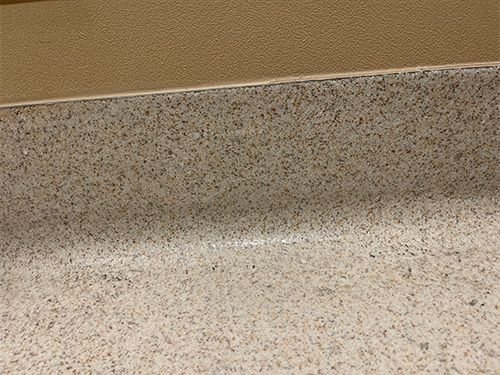Floor Coving
Integral Cove Base For Industrial and Commercial Epoxy Installations
What is Floor Coving?
Floor coving is used to create a connection point between a wall and the floor. There are various types of cove with different applications. As it pertains to epoxy flooring, however, the typical cove base that’s installed is an integral cove base.
Typically integral epoxy cove is installed at 4” or 6” high. It has a radiused area at the point where the floor “turns upward” into the wall. Alternately 45-degree angles cove can be used. These types of coving are useful to keep dirt and debris from collecting in corners or under something like rubber cove base.
Cleanable, Hygienic, Maintainable
Epoxy integral cove base creates a highly cleanable, chemical resistant, hygienic floor system.
Epoxy or other resinous flooring cove base material prevents water intrusion and also prevents bacteria. The radiused cove eliminates the ability of debris, dirt, grime etc. to collect at the connection between the top of the floor and the base of a wall surface, since it a seamless floor
From a cleanability perspective, many resinous flooring options, especially when married to a cove, create a very easy to clean and maintain surface.
Preventing Equipment From Hitting Walls
Another benefit of epoxy cove system is that it can keep equipment from slamming into and damaging walls.
Either a radiused cove or a cove with an angle can be a great choice where carts, medical equipment, manufacturing equipment etc. could potentially hit the wall.
The cove can stop or at least slow carts before they slam into wall.
Typical Uses:
- Commercial kitchens
- Bathrooms and showers
- Food and beverage processing environments
- Labs and clean rooms
- Medical/healthcare
- Commercial and industrial wet environments
- Walk in coolers
- Chemical production
- Packing and storage areas
- Pharmaceuticals
- Industrial floors
- And more

How to Make and Install Integral Epoxy Cove Base
Floor Prep
Installing integral epoxy cove is done by first prepping the surface and the floor. The concrete floor adjacent to the wall is first ground down and prepped.
Appropriate Backing Surface
An appropriate backing surface is necessary to ensure a successful install. For that reason, it’s important to remove any stainless steel from the walls as epoxy doesn’t bond well to it. Similarly, we typically recommend saw-cutting any FRP along a traced line at 4” or 6”.
While epoxy cove can bond to prepared FRP, over the long run it has a greater tendency to fail as FRP is likely to flex and move.
Most of the time, drywall that is in good shape makes for a perfect backing material.
Applying Cove Mix
Once the cove mix is correctly mixed, it is then troweled onto the base of the wall with a special trowel that has a radius built into the base of it.
Cove goes onto the wall first. After the initial cove base installation is completed, it usually needs to dry until the next day.
After that point, the first coat of the floor is installed and multiple coats are applied on the floor and the cove until the floor is completed.
Cove Base Appearance
In addition to the cleanability, hygienic, and other benefits already mentioned, epoxy integral cove also looks nice and completes a high performance floor. Instead of a cheap looking rubber base that is glued onto a wall, epoxy base seamlessly connects the floor to the wall.
Cove Strip
There are a variety of available cove strip options to create a clean line at the top of the cove where the cove stops and the wall begins.
Typically a clear, white, or other colored plastic cove strip is stuck to the wall prior to building the cove.
Stainless steel and aluminum options are available as well. For those familiar with Schluter transitions, these share a similar appearance.
What is Epoxy Cove Made From?
Epoxy cove is made from a mix of epoxy and quartz sand.
Decorative Cove Base
If quartz or flake is to be applied to the floor to make it a decorative epoxy floor, it is also applied to the cove base. Once any broadcasts of quartz and/or flake have been applied, they are sealed in with a grout coat and finally with a top coat, completing the floor and the cove.
Expert Epoxy and Cove Base Installers
If you have more questions about integral epoxy cove base and whether it’s appropriate for your project, or not, please get in touch.
We’ve been installing epoxy floors with and without cove since 1989 and can give you the appropriate advice for the best execution of your commercial or industrial resinous flooring install.
